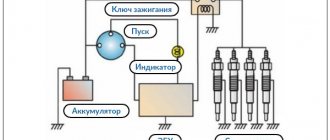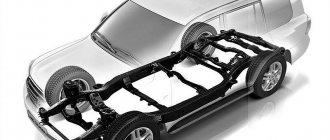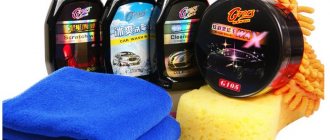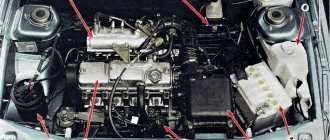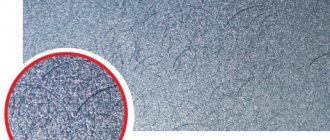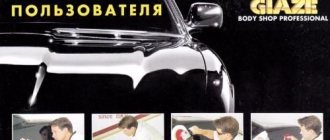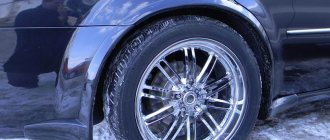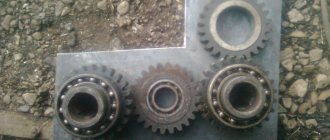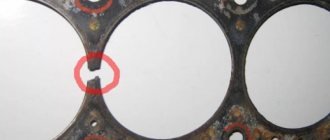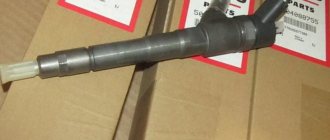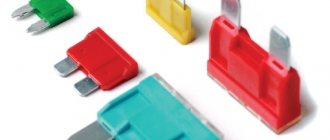What's under the hood? (for Dummies")
So, it all started with my purchase of a car (the choice fell on the VAZ 2107). And as you know, purchasing a car obliges the owner (to begin with) to understand at least a little about its maintenance and, accordingly, repairs. But for me (a novice car enthusiast) everything that was under the hood was a huge secret. Of course, experience is gained over the years, and since I didn’t have the latter (and I knew very little, practically nothing about the “insides” of the car), little by little I began to understand the design features of my Zhiguli. Therefore, so that to my colleagues (novice car enthusiasts) the engine compartment and everything in it does not seem too “dark”, in this article I will tell you what is where and what is responsible for what.
1 - radiator; 2 - battery; 3 - suction pipe; 4 — thermostat; 5 — mounting block of relays and fuses; 6 — air filter; 7 — oil filler plug; 8 — vacuum brake booster; 9 — brake system reservoir; 10 — hydraulic clutch release reservoir; 11 — expansion tank of the cooling system; 12 — washer reservoir; 13 — radiator cap (plug); 14 — ignition coil; 15 — electric fan; 16 — upper radiator hose; 17 — breaker-distributor; 18 — cylinder head cover.
Now about the main thing.
1. Battery – Designed to power electrical equipment when the engine is not running or at low engine speeds. When the engine is running, the power supply is mainly provided by the generator, which also recharges the battery. The battery is one of those items that should be under special attention.
2. Air filter - serves to clean (process) the air entering the engine cylinders. It consists of a housing with an inlet pipe, a cover and a filter paper element. Know that the correct “air” supply to the engine depends on the condition of the filter element. If there is severe clogging or destruction, quite strong losses in power are possible (poor traction).
3. Radiator - serves to remove high temperature from the engine, thereby preserving and reducing wear of engine parts (after all, when the engine is running, temperatures up to 2500 ºС arise, and such a temperature causes strong heating of the parts and their expansion, which can cause intense wear).
4. Radiator cap – hermetically closes the radiator filler neck and serves to automatically regulate the temperature and pressure of the coolant. Structurally, it has inlet and outlet valves.
5. Ignition distributor (distributor) - refers to ignition devices, designed to supply high current to the spark plugs. It consists of a low voltage current breaker and a high voltage current distributor combined in one housing.
6. Gasoline pump (or fuel pump) - serves to supply gasoline (fuel) from the fuel tank to the carburetor under excess pressure. Diaphragm type.
7. Expansion tank - it contains a certain amount of coolant, designed to compensate for the constantly changing volume of liquid in the cooling system of a running engine (by the way, the “supply” of liquid is regulated by a valve in the radiator cap).
8. Windshield washer reservoir - serves to store a certain amount of water, which is supplied to the jets, which, if necessary, clean the glass. Structurally combined with an electric pump.
9. Relay – designed for switching (turning on, turning off, switching...) electrical circuits from an external signal. Structurally, it consists of a relay element (usually a coil) and a group of contacts that open or close depending on the state of the relay element. There are a large number of relays - electrical, optical, thermal, etc.
10. Mounting block - it contains fuses for electrical circuits that protect the car’s electrics from possible short circuits. In addition, it contains relays for switching headlights (high/low), turning on the sound signal, etc.
11. Engine – serves to set the car in motion.
12. Spark plugs - used to ignite the working mixture in the cylinders with a spark. Structurally, it consists of a metal casing, inside of which a ceramic insulator is placed. Inside the insulator there is a central electrode, the upper part of which is steel, and the lower part consists of an alloy of nickel and manganese.
13. Brake fluid reservoir – serves to compensate the brake fluid in the brake system. Structurally, the nutrient tank is combined with a brake fluid level sensor.
14. Clutch fluid reservoir – serves to compensate for the volume of clutch fluid during operation.
Source
General structure of the car
The block diagram of a rear-wheel drive car is shown in Fig. 6.1.1.
The car includes:
- engine 1;
- power train or transmission , which includes: clutch 5, gearbox 7, cardan drive 8, main gear and differential 11, axle shafts 10;
Rice. 6.1.1. Block diagram of a rear-wheel drive car: 1 - engine; 2 — fuel pedal; 3 - generator; 4 — clutch pedal; 5 — clutch; 6 — gear shift lever; 7 — gearbox; 8 — cardan transmission; 9 — wheel; 10 — axle shafts; 11 — main gear and differential; 12 — parking (hand) brake; 13 — main brake system; 14 — starter; 15 — power supply from battery; 16 — suspension; 17 — steering; 18 - hydraulic main
- chassis , which includes: front and rear suspension 16, wheels and tires 9;
- control mechanisms , consisting of steering 17, main 13 and parking 12 brake systems;
- electrical equipment , which includes sources of electric current (battery and generator), electrical consumers (ignition system, starting system, lighting and alarm devices, instrumentation, heating and ventilation systems, windshield wiper, windshield washer, etc.);
- monocoque body.
Front-wheel drive cars do not have a driveshaft or driveshaft box in the body, so the interior becomes more spacious and comfortable, and the vehicle weighs less.
Engine 1 (Fig. 6.1.1) is a machine that converts any type of energy (gasoline, gas, diesel fuel, electric charge) into rotational energy of a cranked engine.
Most modern cars are equipped with piston internal combustion engines (ICE), in which part of the energy released during fuel combustion in the cylinder is converted into mechanical work of rotation of the crankshaft (Fig. 6.1.2).
Displacement is a unit of measurement of engine volume equal to the product of the piston area by the length of its stroke and the number of cylinders. Displacement characterizes the power and size of the engine, expressed in liters or cubic centimeters.
To change the amount of fuel mixture supplied to the cylinder (to change engine power), use the fuel pedal (gas pedal) 2.
Rice. 6.1.2. Appearance of a modern engine: 1 — valve box cover; 2 — neck plug for filling oil into the engine; 3 — cylinder head; 4 - pulleys; 5 - drive belt; 6 - generator; 7 - crankcase; 8 - pallet; 9 — exhaust manifold
A flywheel with a toothed ring is installed on the crankshaft, which is the drive clutch disc 5.
Clutch 5 provides a permanent mechanical connection between the engine and the gearbox and is designed to briefly disable it for the time required to engage or shift gears.
The clutch (Fig. 6.1.3) consists of two friction clutches 1 and 3, pressed against each other by a spring 4. Drive disk 1 is mechanically connected to the engine crankshaft, driven disk 3 is connected to the drive shaft of the gearbox 14.
The clutch is turned on and off by the driver using pedal 8 (when the pedal is pressed, the clutch is disengaged). When you press the pedal, clutch discs 1 and 3 diverge, drive disc 1, connected to engine 13, rotates, but this rotation is not transmitted to driven disc 3 (the clutch is disengaged). The clutch must be disengaged during the period of engaging or shifting gears to ensure a shock-free connection of the gears in the gearbox.
When the pedal is smoothly released, the drive and driven disks engage smoothly. At the same time, due to slipping, the driving disk smoothly imposes rotation on the driven disk. It begins to rotate, transmitting torque to the input shaft of gearbox 14. Thus, the car can start moving smoothly from a standstill or continue moving in a new gear.
The gearbox serves to change the magnitude and direction of torque and transmit it from the engine to the drive wheels, as well as for long-term disconnection of the engine from the drive wheels while the vehicle is parked.
The gearbox can be mechanical (with manual gear shift) or automatic (torque converter, robotic or CVT).
Rice. 6.1.3. Clutch diagram: 1 - flywheel; 2 — clutch driven disc; 3 — pressure disk; 4 - spring; 5 — release levers; 6 — release bearing; 7 — clutch release fork; 8 — clutch pedal; 9 — clutch master cylinder; 10 - hydraulic fluid; 11 - pipeline; 12 — clutch slave cylinder; 13 — engine; 14 — drive shaft of the gearbox; 15 - gearbox
We recommend: Buying cars at AvtoRoom
The manual gearbox (Fig. 6.1.4) is a gearbox with a stepwise variable gear ratio.
It contains:
- crankcase 12, which contains oil 13 for lubricating rubbing parts;
- input shaft 2 connected to clutch driven disc 1
- input shaft gear 3, which is permanently connected to the intermediate shaft gear;
- intermediate shaft 4 with a set of gears of different diameters;
- a secondary shaft 9 with a set of gears that can be moved using the gear shift fork 6;
- gear shift mechanism 8 with shift lever 7;
- synchronizers are devices that ensure equalization of gear rotation speeds during gear changes.
The driver changes gears using shift lever 7. Since the gearbox of a modern car has a large set of gears, by engaging different pairs of them (when engaging any gear), the driver also changes the overall gear ratio (gear ratio). The lower the gear, the lower the vehicle speed, but the greater the torque and vice versa.
When the engine is running, before turning on or shifting gears in a manual transmission, in order to shift gears without shock, you need to depress the clutch pedal (disengage the clutch).
Rice. 6.1.4. Manual gearbox: 1 — clutch; 2 - input shaft; 3 - drive gear; 4 - intermediate shaft; 5 — secondary shaft gear; 6 — gear shift fork; 7 — gear shift lever; 8 - switching device; 9 — secondary shaft; 10 — crosspiece; 11 — cardan transmission; 12 - crankcase; 13 - gearbox oil
The most common gear shift patterns in passenger cars are shown in Fig. 6.1.5.
Rice. 6.1.5. The most common gear shift patterns in passenger cars are 1 and 2, 3 and 4 - using the gear lever
The automatic gearbox (Fig. 6.1.6) includes:
- The torque converter (2, 5, 4, 5, 9), which is directly connected to the engine, is filled with hydraulic fluid 10. The fluid is the medium for transmitting torque from the engine to the manual transmission. The principle of operation is as follows: with increasing engine speed, the revolutions of shaft 2 with blades 3 increase, which cause rotation of the hydraulic fluid 10. The rotating fluid begins to put pressure on the blades of the secondary shaft 4 and causes rotation of the secondary shaft. The torque converter essentially acts as a clutch;
- The manual gearbox 7 receives rotation from the torque converter, gear shifting in it is carried out by servo drives according to commands from the control unit 6.
Rice. 6.1.6. Automatic gearbox: 1 — engine; 2 - input shaft; 3 — blades of the input shaft; 4 — blades of the secondary shaft: 5 — secondary shaft; 6 — automatic transmission control unit; 7 — manual gearbox; 8 - output shaft
To control an automatic, robotic or CVT transmission, use the gear selector (Fig. 6.1.7).
Rice. 6.1.7. Typical diagrams of automatic gearbox selectors:
P - parking, mechanically blocks the gearbox; R - reverse gear, should only be engaged after the vehicle has come to a complete stop; N - neutral, in this position you can start the engine; D - drive, forward movement; S (D3) - low gear range, activated on roads with slight inclines. Engine braking is more effective than in position D; L (D2) - second range of low gears. Turns on on difficult road sections. Engine braking is even more effective
A cardan drive (in rear- and all-wheel drive vehicles) allows torque to be transmitted from the gearbox to the rear axle (main gear) when the vehicle is moving on a rough road (Fig. 6.1.8).
Rice. 6.1.8. Cardan transmission: 1 - front shaft; 2 — cross; 3 - support; 4 — cardan shaft; 5 - rear shaft
Main gear 5 serves to increase torque and transmit it at right angles to axle shaft 6 of the vehicle (Fig. 6.1.9).
The differential ensures that the drive wheels rotate at different speeds when the car turns and the wheels move on uneven roads.
Axle shafts 6 transmit torque to drive wheels 7.
The chassis ensures movement and smoothness. It includes a subframe, usually combined with the car body, to which elements of the front and rear axles with hubs and wheels 7 are attached via front and rear suspensions.
Mechanisms and parts of the chassis connect the wheels to the body, dampen its vibrations, perceive and transmit forces acting on the car.
While inside a passenger car, the driver and passengers experience slow vibrations with large amplitudes and fast vibrations with small amplitudes. Soft seat upholstery, rubber engine mounts, gearboxes, etc. protect against fast vibrations. Elastic suspension elements, wheels and tires protect against slow vibrations.
Rice. 6.1.9. Rear-wheel drive car: 1 - engine; 2 — clutch; 3 — gearbox; 4 — cardan transmission; 5 — main gear; 6 — axle shaft; 7 — wheel; 8 — spring suspension; 9 — spring suspension; 10 - steering
The suspension (Fig. 6.1.10) is designed to soften and dampen vibrations transmitted from road irregularities to the car body. Thanks to the wheel suspension, the body makes vertical, longitudinal, angular and transverse angular vibrations. All these vibrations determine the smoothness of the car. The suspension can be dependent or independent.
Dependent suspension (Fig. 6.1.10), when both wheels of one vehicle axle are connected to each other by a rigid beam (rear wheels). When one of the wheels hits an uneven road, the other one tilts at the same angle. Independent suspension, when the wheels of one axle of the car are not rigidly connected to each other. When hitting an uneven road, one of the wheels may change its position, but the position of the second wheel does not change.
Rice. 6.1.10. Diagram of operation of dependent (a) and independent (b) car wheel suspension
An elastic suspension element (spring or spring) serves to soften shocks and vibrations transmitted from the road to the body.
Rice. 6.1.11. Shock absorber diagram:
1 — car body; 2 — rod; 3 - cylinder; 4 — piston with valves; 5 — lever; 6 — lower eye; 7 — hydraulic fluid; 8 - upper eye
We recommend: Porsche Technical Center - the ideal service option
The damping element of the suspension - the shock absorber (Fig. 6.1.11) - is necessary to dampen body vibrations due to the resistance that occurs when fluid 7 flows through calibrated holes from cavity “A” to cavity “B” and back (hydraulic shock absorber). Gas shock absorbers can also be used, in which resistance occurs when gas is compressed. A vehicle's anti-roll bar is designed to improve handling and reduce vehicle roll when cornering. When turning, the car body presses one side of it to the ground, while the other side wants to go “away” from the ground. It’s the anti-roll bar, which, pressing one end to the ground, presses the other side of the car with the other, preventing him from getting away. And when a wheel hits an obstacle, the stabilizer rod twists and tries to return this wheel to its place.
Rice. 6.1.12. Steering diagram of the "gear-rack" type: 1 - wheels; 2 — rotary levers; 3 — steering rods; 4 — steering rack; 5- gear; 6-wheel steering
Steering (Fig. 6.1.12) is used to change the direction of movement of the vehicle using the steering wheel. When the steering wheel 6 rotates, the gear 5 rotates and moves the rack 4 in one direction or another. When moving, the rack changes the position of the rods 3 and the associated rotary levers 2. The wheels turn.
Rice. 6.1.13. Brake system: main - 1-6 and parking (manual) -7-10. Actuating brake devices: A - disc; B - drum type; 1 - main brake cylinder; 2 - piston; 3 - pipelines; 4 — hydraulic brake fluid; 5 — rod; 6 — brake pedal; 7 — hand brake lever; 8 - cable; 9 — equalizer; 10 - cable
The brake system (Fig. 6.1.13) serves to reduce the speed of rotation of the wheels due to the friction forces arising between the brake pads 11 and brake drums A or discs B, as well as to hold the car stationary in parking lots, on descents and ascents with the help of manual brake system (7-10). The driver controls the brake system using the brake pedal 6 of the main brake system and the parking-night (hand) brake lever 7.
The main brake system (1-6), as a rule, is multi-circuit, that is, when you press the brake pedal 6, the pistons 2 move, the pressure of the hydraulic brake fluid 4 is transmitted through pipelines 3 to the brake actuators A - for braking the front wheels and the brake actuators B - for braking the rear wheels. Systems A and B are independent of each other. If one circuit of the brake system fails, the other will continue to perform the braking function, although less effectively. The multi-circuit braking system increases traffic safety.
The electrical equipment of a car includes sources of electric current (battery, generator) and electrical consumers (starting and ignition systems, lighting, alarm devices, instrumentation, windshield wipers, windshield washers, heating, ventilation systems, etc.).
The battery energy is used when the engine is not running, the generator energy is generated only when the engine is running, it is used to recharge the battery and power other vehicle consumers.
body is rigid and load-bearing.
Mat. part for novice drivers - What is under the hood of the car
For those drivers who want to start servicing their car themselves and who are simply interested in expanding their horizons, it is vitally important to begin their acquaintance and study of the car with its internals and technologies, which are permeated (stuffed) with the entire engine compartment of the car. Dear readers, in today’s lecture we would like to introduce you to two types of engines of foreign car brands. Many of us (you) could see and personally see the first of these engines in cars from the USA. The second type of motors spread throughout the world and in the 90s became a very popular type of engine, one of which is quite possibly installed in your personal car today.
We would like to point out right away that the information that you will get acquainted with here today is of a general nature, since each of the engines, even of the same volume, the same type and the same technological level, is always purely individual, and sometimes can even be significantly differ in its technological terms from other similar power units.
Therefore, we offer you the following, if you are aware of all the above terms, you can immediately skip this article and move on to reading our other material:
Well, if you, dear friends, have just or recently plunged into the world of cars, then we wish you a pleasant reading. We hope that you will discover something new and not yet explored.
New discoveries under the hood
Precautionary measures when working in the engine compartment of a car. You probably all know that a car is a highly dangerous vehicle on the road. It remains that way in the garage, in the parking lot, and in other similar places. The car contains a huge number of different technical devices that can cause real physical injuries to a person who climbs inside under the hood of the car.
Car design for dummies: let's figure it out together
The invention of the automobile radically changed human life, both positively and negatively. Today, a car is not only a means of transportation, but also an indicator of status and position in society.
Almost every family has at least one car at its disposal, and there are also cities where there have long been more cars than people.
Perhaps for some, the design of a car is higher mathematics, but if you spend a little time and understand the essence, everything is quite simple. Now let's talk about everything in order.
This information will be useful to you
Have you read to the end, friends? How was your first virtual acquaintance with the car? Perhaps you think that everything is very complicated and unclear? Don't worry, everyone started out this way at some point. Studying this topic and practicing it in the future will yield positive results. You will learn how to maintain your car yourself. At first it will be a simple check of the fluid level, an inspection of the general condition of the engine and its components, and then everything else will come. You will learn to identify various leaks, the condition of car hoses, simple technical breakdowns, for example, loose battery terminals or loose clamps. Further more and more, in the end, before you have time to blink your eye, you will learn how to change the oil in the engine, in the gearbox and change the brake pads yourself. Who knows, maybe you will like servicing the car so much that you will learn how to rebuild the engine and suspension yourself? All your friends are in your hands.
Until then, if you have an interest in this, start studying and studying operating instructions for cars, read forums and ask an experienced friend to show you the basics of car maintenance using the example of your personal car.
Tip: When replacing a battery (battery), first remove the negative (negative) terminal, then the positive (positive) terminal. The terminals are put back in a similar asymmetric order, i.e., first positive to positive, and then negative to negative.
Get yourself a journal in which you will record all the work you have done on the car. Note in it at what mileage these works were performed. After all, only with regular and proper maintenance will your car last a long time and will mainly bring you only joy, and not disappointment from sudden and unforeseen breakdowns.
Source
Car body
The basis of any car is its body, which is the body of the car that houses the driver, passengers and cargo. It is in the body that all other elements of the car are located. One of its main purposes is to protect the people and cargo in it from the influence of the external environment.
Usually the body is mounted on a frame, but there are also cars with a frameless design, and then the body simultaneously performs the functions of a frame. The car body structure is:
Depending on the nature of the load, the body can have three types:
Most modern passenger cars have a supporting structure that absorbs all the loads acting on the car. The general structure of a passenger car body includes the following basic elements:
Body load-bearing system. This system allows you to reduce the weight of the vehicle, lower the center of gravity, and therefore increase driving stability.
Brief overview of types of motors
First of all, it is worth noting that the engine and motor are one and the same. Motors are often called internal combustion or electric engines. It is no secret that the engine serves as a source of energy to move the vehicle. Most cars have internal combustion engines
, which can be roughly divided into:
• Piston engines, in which expanding gases during fuel combustion force the piston to move, which in turn drives the crankshaft of the car;
• In rotary engines, the same gases drive a rotating part, the rotor itself.
If you go deeper, there are a large number of types and subtypes of engines. Based on the type of fuel, engines can be divided into diesel, gasoline, gas and gas generators.
There are also gas turbine internal combustion engines, electric, orbital, rotary, rotary-vane, etc. Today, the most common is the piston internal combustion engine.
Bottom view
The front of the car.
The levers, braces and anti-roll bar of the front suspension are clearly visible (like the front wheels, they belong to the group of chassis elements).
1 – front wheel suspension arm (chassis); 2 – lever extension (chassis); 3 – engine (sump pan with oil drain plug); 4 – gearbox; 5 – front wheel drive shaft (front wheel drives belong to the transmission); 6 – anti-roll bar (chassis); 7 – exhaust system (exhaust system).
The back of the car's underbody.
The beam is clearly visible, the shock absorbers and springs of the rear suspension are partially visible.
The main muffler of the exhaust system is located next to the wheel. At the rear of the car, behind the rear suspension beam, you can see a niche in the bottom of the trunk, which houses the spare wheel. 1 – shock absorber; 2 – rear suspension beam (chassis); 3 – fuel filter of the power supply system (only a car with an injection engine); 4 – main muffler of the exhaust gas system; 5 – niche in the bottom of the trunk for a spare wheel.
The bottom of the car under the driver and front passenger seats.
Under the bottom, parallel to the additional muffler pipe, there is a transmission control drive rod.
1 – additional exhaust system muffler; 2 – pipelines for hydraulic drive of the brake system and engine power supply system; 3 – drive rod for controlling the gearbox (transmission).
The bottom of the car under the seats of the rear passengers.
The fuel tank is located under the bottom, in front of the rear suspension beam.
Near the fuel tank, there is a pressure regulator that adjusts the brake fluid pressure in the brake mechanisms of the rear wheels. The pressure regulator belongs to the brake system. 1 – additional exhaust system muffler; 2 – fluid pressure regulator in the brake mechanisms of the rear wheels; 3 – fuel tank.
What does a car consist of?
Any passenger car contains the following components:
- engine
- transmission
- chassis
- electrical equipment
- body
This is the order in which a car is always discussed in any textbook on auto mechanics, and there is a reason for this: these components are arranged in order of importance.
Engine
The engine of a car is its main part. It drives the vehicle itself and simultaneously supplies energy to the service units. The engine is almost always located in the front, but sometimes it is also located in the rear (mainly on sports cars). The most common today is the internal combustion engine (ICE) - it burns fuel, converting thermal energy into kinetic energy (rotation). Engines are petrol, diesel and gas. In these three cases, the difference lies only in the type of fuel used and the characteristics of the engine operating cycle. By the way, you can put a diesel engine in the Niva. There are also electric car engines, but they are a minority, despite their undoubted advantages.
The engine torque must be realized as efficiently as possible, because when driving slowly, the engine cannot work slowly, and when driving quickly, it cannot work quickly. The transmission converts the engine's rotational speed, slowing it down or speeding it up. The transmission consists of a clutch, gearbox and final drive with a differential.
The clutch serves to mechanically separate the wheels and engine when vehicle movement is not required. The gearbox allows you to drive at different speeds at the same engine speed. It can be mechanical (manual) or automatic. In the first case, the gears are switched on by the driver himself using a special lever; in the second, the gears are selected automatically depending on the driving speed and the load on the car. The second option makes it easier to control, but the design of such a unit itself is much more complicated. The final drive sends torque directly to the wheels, and the differential allows them to rotate at different speeds (this is mainly needed when cornering).
Also, the composition of the transmission may vary depending on the type of drive. The engine can turn only the front wheels, only the rear wheels, or all wheels together. In the first case, rotation from the main gear goes through the axle shafts directly to the front wheels. In the second case (if the engine is in the front), a special driveshaft is added to the transmission, leading to the rear wheels through the entire car. On all-wheel drive vehicles (jeeps and crossovers), after the gearbox, another transfer case is installed, which distributes rotation between the front and rear wheels.
Chassis
It includes components directly related to movement - suspension, wheels, brake mechanisms. The car's suspension serves to smooth out the reactive moments that arise when driving over uneven surfaces, in other words, it makes the ride softer and smoother. In addition, the suspension eliminates and reduces body roll and tilt when cornering, keeping the car in a given horizontal position. The suspension includes shock absorbers and springs, as well as various levers and joints. The smoothness of the ride and overall behavior on the road depend on the characteristics of the suspension. Brakes are used to slow down and stop a car in various situations. They are located directly next to the wheels.
Electrical equipment
Electrical equipment is a very important equipment system. Nowadays, when there are more and more electronic assistants, the role of electrical equipment is becoming increasingly important. In its most general form, it consists of a battery, a generator, ignition systems, lighting, and control devices. Since various systems consume a lot of electricity, the engine, during its operation, rotates the generator, which supplies all consumers, and also charges the battery, which is used to start the engine.
We recommend: Car suspension: elements, diagram, types
Body
The body is, roughly speaking, a metal box in which all of the above units are installed. The body, together with attached parts (doors, hood, wings) form the appearance of the car and protect the driver, passengers and all components from atmospheric influences. Almost all modern passenger cars are equipped with monocoque bodies, i.e. All components are installed on it, unlike trucks, for example, where a frame is used - a special element to which the engine, cabin, body, suspension, etc. are attached. The use of a monocoque body allows you to significantly, by 10-20%, reduce the total weight.
Of course, numerous pictures and books can give a more complete idea of the structure of the machine, but general theoretical knowledge in most cases is quite enough to understand, for example, that problems with electrical equipment can be the reason why the engine “troubles”, and knocks and rumbles When driving over uneven surfaces, this indicates a problem with the suspension. Therefore, the design of a car for “dummies”, despite the complexity of the systems and the abundance of car services, will always be able to help in a difficult situation.
In the twenty-first century, a car is no longer a luxury. Most likely, this is an urgent need. However, most vehicle owners simply do not have enough time to carefully study its components. Therefore, the design of a car for “dummies” allows you to become familiar with the fundamentally important points in the shortest possible time.
The simplest diagram of a car looks like this:
- top shell or ;
- chassis apparatus (transmission, control mechanisms, running gear);
- the power unit, which is the most important part of the car.
Car engine, its types
The heart of the car, its main component, is the engine. It is this part of the car that creates torque, which is transmitted to the wheels, causing the car to move in space. Today there are the following main types of car engines:
It is a set of mechanisms that convert the thermal energy of the fuel burning in its cylinders into mechanical energy.
According to the type of fuel burned, all internal combustion engines are divided into the following types:
According to the design of internal combustion engines there are:
What's next?
Gas 4-stroke internal combustion engine of Nikolai-August Otto and Eugene Langen (1876)
Marketing of the global auto industry is quite simple. Every 3-5 years, the consumer must change the car, and, of course, for a more modern, improved one - more economical, environmentally friendly, powerful and easy to operate. From an environmental point of view, the surest way is to switch us all to electric cars. Indeed, an electric car produces almost no emissions of harmful substances. In addition, the electric motor has high torque at low speeds. An electric car requires fewer adjustments, is not critical to lubrication, has a simpler cooling system, and does not have a fuel system at all. The main drawback that holds back the adoption of electric vehicles is the low energy consumption of batteries. The tank of a small car, filled to capacity, weighs about 50 kg, providing a power reserve of more than half a thousand kilometers. Batteries usually weigh several hundred kg, and the range on fully charged batteries does not exceed 100–150 km, and when driving at low speed. But that's not even the biggest problem. If all cars today were replaced by electric vehicles, they simply would not have enough electricity. The fact is that the total power of the engines of the world vehicle fleet is several tens of times greater than the total power of all power plants in the world.
As you know, not so long ago, designers of a number of leading companies proposed a palliative - to place an individual power plant on board the car: piston internal combustion engine - generator - battery - electric motor. In city driving mode, the main load is carried by the electric motor, on the highway - by the internal combustion engine, which simultaneously charges the batteries. The operating algorithm of the entire system is designed so that the internal combustion engine constantly operates in the most optimal mode, both from an economical and environmental point of view. Hybrid vehicles are becoming increasingly accepted, especially where environmental regulations are most stringent.
Alternatives
Prosper L'Orange (1876–1939), father of the modern diesel engine, worked for Benz & Cie.
The first successful design of this kind - a gas turbine - was developed before World War II. A gas turbine engine is free from almost all the disadvantages of a piston engine. It has greater efficiency, it has no valves, no timing, no crank mechanism, no pistons, no cylinders. Just a turbine (many light blades on a rotating disk) and a compressor (again many blades on another disk). And such a motor, in principle, can operate on any type of liquid or gaseous fuel - as long as it burns.
However, the gas turbine has at least two disadvantages that cast great doubt on its installation on a car. The first one is several times larger compared to a piston
ICE rotation speed, and the second – greater inertia. Well, the turbine doesn’t like to accelerate quickly and stop quickly. For airplanes, these shortcomings are insignificant, but for a car they are more than critical.
German engineer Felix Wankel proposed his own version of an internal combustion engine without a crank mechanism - a rotary piston engine (RPE). By the way, there were no valves there either. This invention amazed me with its elegance. Imagine that inside a chamber of a complex shape, a triangular rotor moves along a complex trajectory. It constantly divides the chamber into working zones, in which intake, compression, stroke and exhaust occur, while the role of pistons is performed by the three sides of the rotor. The rotor is connected by a gear to an eccentric shaft. The Wankel engine is not burdened with parts, therefore it has high
specific power and throttle response; moreover, the RPD is much more compact and lighter than a piston internal combustion engine. However, the design of the Wankel engine has its own inherent problems. The complexity of the shape of the chamber and rotor makes it expensive to manufacture and short-lived, and incomplete combustion of the working mixture leads to high fuel consumption.
Steering
To move normally in a car, the driver needs to make turns, U-turns or detours, that is, deviate from straight-line movement, or simply control his car so that it does not drift to the side. For this purpose, its design provides steering control. This is one of the simplest mechanisms in a car. Let's look at the names of some of the elements below. The steering system consists of:
These devices consist of a steering system that is connected to the front wheels by steering and brakes.
Modern cars use an additional element - power steering, which allows the driver to use less force to turn the steering wheel. It comes in the following types:
Device
In most cases, the hood is attached to the body on hinges and has a lock with a remote drive from a lever or handle located in the cabin or, less commonly, on the radiator grille. Ford used on some of its cars (Focus II, Mondeo III) a hood lock drive from a key, the keyhole for which was located behind the folding factory emblem on the radiator grille. The hinges can be located both in front (the hood opens against the direction of travel, tilting up and forward) and behind the hood (opens in the direction of travel, tilting up and back). The latter is more convenient, but requires a very reliable lock, since the hood can be opened while moving by the incoming air flow. On some cars, the hood opened to the side - for example, on the GAZ-12 ZIM it could be opened to the right or left (with the lock on the opposite side serving as a hinge), or even simply removed, for which it was necessary to open both locks at the same time.Until the mid-1930s, the hood on most cars consisted of two halves connected by a piano hinge, which opened to the side independently of each other. The hinge axis was fixed in the engine shield and on the radiator lining. Subsequently, the so-called “alligator” hoods, opening up and back, became widespread, which over time replaced hoods with two halves. “Alligator” hoods, due to weak locks, were prone to being opened by air flow while moving, so in the second half of the 1950s, so-called “safe” hoods with front hinges began to be used, which, when opened, folded up and forward. However, the inconvenience of access to the engine led to the return of rear-hinged hoods in the 1970s, now combined with more secure locks that prevent accidental opening while driving.
On budget cars, the hood usually has simple hinges and is secured in the open position by a folding strut. On more expensive models, there are spring-loaded hinges, which, when the lock is open, themselves lift the hood to the upper position and hold it in it, or gas stops that perform the same function.
On racing cars, as well as tuned ones that imitate them, the hood may not have hinges, but instead it is held in place with the help of long pins that fit into reciprocal recesses on the engine compartment shield, and external locks (the so-called “racing”) - in this case it is convenient to remove for maintenance, repair or replacement of the engine. In most countries, the operation of vehicles with such a hood mount is prohibited on public roads. In some cases, the entire front of the car is foldable, including the fenders and bumper, which in this case is usually made of fiberglass or carbon fiber for the purpose of lightness.
For carriage-type cars, the hood may be internal, accessible from the passenger compartment. For example, in the UAZ-452 it is a removable metal cap located between the driver and front passenger seats. In another case (most truck tractors), the entire cabin acts as a hood, tilting on hinges for access to the engine (which does not exclude the possibility of having a separate hood inside the cabin, used for adjustments and minor repairs).
For rear-engine cars, the hood is located at the rear of the body, and there is a trunk lid at the front. Rear-engine station wagons (for example, Volkswagen Typ 4 Variant) usually have an internal hood, accessible from the luggage compartment when the rear door is open. In some mid-engine cars and sidecars, access to the engine was provided from the passenger compartment by folding down the back of the rear seat.
The hood, as a clearly visible part of the front of a car, is often used to install various decorative elements - for example, a hood figure or an ornament in the form of the manufacturer's emblem. Its shape and design are influenced by the layout of the engine compartment and the design features of the power unit. For example, on low sports cars, as well as mass-produced models with a very large engine (for example, the Volga GAZ-24), a special stamping has to be done on the hood above the engine, which is sometimes styled as an air intake. Thanks to this, it is possible to combine sufficient height space for the engine with a low hood, providing good visibility from the driver’s seat. Much less commonly used is a real functional bonnet air intake, which serves to supply air to the engine under some pressure (inertial boost).
Windshield washer nozzles are located on the hoods of modern cars. The inside of the hood is often covered with a special sound-absorbing material - polymer (foamed plastic) or natural (usually felt). The rear of the hood acts as a spoiler, cutting off air flow from the recess in front of the windshield that houses the windshield wipers.
To protect the windshield and the front of the car, install a hood deflector. It is a plastic screen that follows the contours of the car hood. The functional purpose of the hood deflector is to protect the paint surface of the front of the car and the aerodynamic zone of the deflector screen shadow. Getting into the upper flow, small particles of dirt, flies, dust go around the hood and windshield without coming into contact with them. Even a small stone that hits the deflector is thrown higher than the car.
Hood locks are sometimes protected by anti-theft system elements located under the hood, that is, in the engine compartment. The main task of mechanical hood locks is to prevent unauthorized access to the engine compartment. The hood lock design usually consists of two parts. Control part - recognizes the control signal from an external electronic device or turning the key in the lock cylinder, and by moving the cable inside the casing it transmits the action to the lock part, blocking the standard lock or engaging with a specially installed metal “loop”.
Brake system
An important part of the machine that ensures safe driving is the braking system. Its main purpose is to forcefully stop a moving vehicle. It is also used when it is necessary to sharply reduce the speed of the car.
The brake system is of the following types according to the type of drive:
Modern passenger cars are equipped with a hydraulic brake system, which consists of the following elements:
Brake pads are either disc or drum and have a return spring that presses them away from the wheel rim when the braking process is complete.
Excerpt characterizing the Hood (car)
Pursued by a hundred thousand French army under the command of Bonaparte, met by hostile inhabitants, no longer trusting their allies, experiencing a lack of food and forced to act outside all foreseeable conditions of war, the Russian army of thirty-five thousand, under the command of Kutuzov, hastily retreated down the Danube, stopping where it was overtaken by the enemy, and fought back with rearguard actions, only as much as was necessary in order to retreat without losing weight. There were cases at Lambach, Amsteten and Melk; but, despite the courage and fortitude, recognized by the enemy himself, with whom the Russians fought, the consequence of these affairs was only an even faster retreat. The Austrian troops, having escaped capture at Ulm and joined Kutuzov at Braunau, now separated from the Russian army, and Kutuzov was left only to his weak, exhausted forces. It was impossible to even think about defending Vienna any longer. Instead of an offensive, deeply thought-out, according to the laws of the new science - strategy, war, the plan of which was transferred to Kutuzov when he was in Vienna by the Austrian Gofkriegsrat, the only, almost unattainable goal that now seemed to Kutuzov was to, without destroying the army like Mack under Ulm, to connect with the troops coming from Russia. On October 28, Kutuzov and his army crossed to the left bank of the Danube and stopped for the first time, putting the Danube between themselves and the main forces of the French. On the 30th he attacked Mortier’s division located on the left bank of the Danube and defeated it. In this case, trophies were taken for the first time: a banner, guns and two enemy generals. For the first time after a two-week retreat, the Russian troops stopped and, after a struggle, not only held the battlefield, but drove out the French. Despite the fact that the troops were stripped, exhausted, weakened by one third, backward, wounded, killed and sick; despite the fact that the sick and wounded were left on the other side of the Danube with a letter from Kutuzov, entrusting them to the philanthropy of the enemy; despite the fact that the large hospitals and houses in Krems, converted into infirmaries, could no longer accommodate all the sick and wounded, despite all this, the stop at Krems and the victory over Mortier significantly raised the morale of the army. Throughout the entire army and in the main quarters, the most joyful, although unfair, rumors were circulating about the imaginary approach of columns from Russia, about some kind of victory won by the Austrians, and about the retreat of the frightened Bonaparte. Prince Andrei was during the battle with the Austrian general Schmitt, who was killed in this case. A horse was wounded under him, and he himself was slightly grazed in the arm by a bullet. As a sign of the special favor of the commander-in-chief, he was sent with news of this victory to the Austrian court, which was no longer in Vienna, which was threatened by French troops, but in Brunn. On the night of the battle, excited, but not tired (despite his weak-looking build, Prince Andrei could endure physical fatigue much better than the strongest people), having arrived on horseback with a report from Dokhturov to Krems to Kutuzov, Prince Andrei was sent that same night courier to Brunn. Sending by courier, in addition to rewards, meant an important step towards promotion. The night was dark and starry; the road turned black between the white snow that had fallen the day before, on the day of the battle. Now going over the impressions of the past battle, now joyfully imagining the impression that he would make with the news of victory, remembering the farewell of the commander-in-chief and comrades, Prince Andrei galloped in the mail chaise, experiencing the feeling of a man who had waited for a long time and had finally achieved the beginning of the desired happiness. As soon as he closed his eyes, the firing of rifles and cannons was heard in his ears, which merged with the sound of wheels and the impression of victory. Then he began to imagine that the Russians were fleeing, that he himself had been killed; but he quickly woke up, with happiness as if he learned again that none of this had happened, and that, on the contrary, the French had fled. He again remembered all the details of the victory, his calm courage during the battle and, having calmed down, dozed off... After the dark starry night, a bright, cheerful morning came. The snow melted in the sun, the horses galloped quickly, and new and varied forests, fields, and villages passed indifferently to the right and left. At one of the stations he overtook a convoy of Russian wounded. The Russian officer driving the transport, lounging on the front cart, shouted something, cursing the soldier with rude words. In the long German vans, six or more pale, bandaged and dirty wounded were shaking along the rocky road. Some of them spoke (he heard Russian dialect), others ate bread, the heaviest ones silently, with meek and painful childish sympathy, looked at the courier galloping past them. Prince Andrei ordered to stop and asked the soldier in what case they were wounded. “The day before yesterday on the Danube,” answered the soldier. Prince Andrei took out his wallet and gave the soldier three gold coins. “For everyone,” he added, turning to the approaching officer. “Get well, guys,” he addressed the soldiers, “there’s still a lot to do.” - What, Mr. Adjutant, what news? – the officer asked, apparently wanting to talk. - Good ones! “Forward,” he shouted to the driver and galloped on. It was already completely dark when Prince Andrei entered Brunn and saw himself surrounded by tall buildings, the lights of shops, house windows and lanterns, beautiful carriages rustling along the pavement and all that atmosphere of a large, lively city, which is always so attractive to a military man after the camp. Prince Andrei, despite the fast ride and sleepless night, approaching the palace, felt even more animated than the day before. Only the eyes sparkled with a feverish brilliance, and thoughts changed with extreme speed and clarity. All the details of the battle were vividly presented to him again, no longer vaguely, but definitely, in a condensed presentation, which he made in his imagination to Emperor Franz. He vividly imagined random questions that could be asked of him, and the answers that he would make to them. He believed that he would immediately be presented to the emperor. But at the large entrance of the palace an official ran out to him and, recognizing him as a courier, escorted him to another entrance. - From the corridor to the right; there, Euer Hochgeboren, [Your Highness,] you will find the adjutant on duty in the wing,” the official told him. - He takes you to the Minister of War. The adjutant on duty in the wing, who met Prince Andrei, asked him to wait and went to the Minister of War. Five minutes later, the aide-de-camp returned and, bending especially politely and letting Prince Andrei go ahead of him, led him through the corridor into the office where the Minister of War was working. The aide-de-camp, with his exquisite politeness, seemed to want to protect himself from the Russian adjutant’s attempts at familiarity. Prince Andrei's joyful feeling weakened significantly when he approached the door of the War Minister's office. He felt insulted, and the feeling of insult at that same moment, unnoticed by him, turned into a feeling of contempt, based on nothing. His resourceful mind at the same moment suggested to him the point of view from which he had the right to despise both the adjutant and the minister of war. “They must find it very easy to win victories without smelling gunpowder!” he thought. His eyes narrowed contemptuously; He entered the office of the Minister of War especially slowly. This feeling intensified even more when he saw the Minister of War sitting over a large table and for the first two minutes did not pay attention to the newcomer. The Minister of War lowered his bald head with gray temples between two wax candles and read, marking with a pencil, the papers. He finished reading without raising his head, when the door opened and footsteps were heard. “Take this and hand it over,” the Minister of War said to his adjutant, handing over the papers and not yet paying attention to the courier. Prince Andrei felt that either of all the affairs that occupied the Minister of War, the actions of Kutuzov’s army could least of all interest him, or it was necessary to let the Russian courier feel this. “But I don’t care at all,” he thought. The Minister of War moved the rest of the papers, aligned their edges with the edges and raised his head. He had a smart and characteristic head. But at the same moment as he turned to Prince Andrei, the intelligent and firm expression on the face of the Minister of War, apparently habitually and consciously changed: the stupid, feigned, not hiding his pretense, smile of a man who receives many petitioners one after another stopped on his face . – From General Field Marshal Kutuzov? - he asked. - Good news, I hope? Was there a collision with Mortier? Victory? It's time! He took the dispatch, which was addressed to him, and began to read it with a sad expression. - Oh my god! My God! Shmit! - he said in German. - What a misfortune, what a misfortune! Having run through the dispatch, he put it on the table and looked at Prince Andrei, apparently thinking about something. - Oh, what a misfortune! The matter, you say, is decisive? Mortier was not taken, however. (He thought.) I am very glad that you brought good news, although the death of Shmit is an expensive price to pay for victory. His Majesty will probably wish to see you, but not today. Thank you, take a rest. Tomorrow be on the way out after the parade. However, I'll let you know.
What's under the hood? (for Dummies")
So, it all started with my purchase of a car (the choice fell on the VAZ 2107). And as you know, purchasing a car obliges the owner (to begin with) to understand at least a little about its maintenance and, accordingly, repairs. But for me (a novice car enthusiast) everything that was under the hood was a huge secret. Of course, experience is gained over the years, and since I didn’t have the latter (and I knew very little, practically nothing about the “insides” of the car), little by little I began to understand the design features of my Zhiguli. Therefore, so that to my colleagues (novice car enthusiasts) the engine compartment and everything in it does not seem too “dark”, in this article I will tell you what is where and what is responsible for what.
1 - radiator; 2 - battery; 3 - suction pipe; 4 — thermostat; 5 — mounting block of relays and fuses; 6 — air filter; 7 — oil filler plug; 8 — vacuum brake booster; 9 — brake system reservoir; 10 — hydraulic clutch release reservoir; 11 — expansion tank of the cooling system; 12 — washer reservoir; 13 — radiator cap (plug); 14 — ignition coil; 15 — electric fan; 16 — upper radiator hose; 17 — breaker-distributor; 18 — cylinder head cover.
Electrical equipment
One of the most complex systems of passenger cars with many different elements and wires connecting them, entangling the entire car body, is electrical equipment, which serves to provide electricity to all electrical devices and electronic systems. Electrical equipment includes the following devices and systems:
Source
| 7 Radiator cap (DO NOT open it when the engine is hot! To check for pressure before unscrewing, squeeze the radiator hose with your hand. If the hose is elastic or hard, then there is pressure in the system, DO NOT open the cap!) |
| 8 Engine oil filler cap (motor oil is poured here). |
| 9 Engine oil dipstick (turn off the engine before checking the oil level and wait 10-15 minutes. Now you can start checking. Keep it low within the min and max risk limits). |
| 10 Components of the air conditioning system (it is strongly NOT recommended to climb into it without knowledge. Freon is pumped into the compressor under pressure). |
| 11 Battery. |
| 12 Information labels (in these labels you can find out information about your car model). |
| 13 Hood latch. |
| 14 Drive belt (drives engine pulleys). |
| 15 Generator (produces energy to run the engine and charge the battery). |
| 16 Fan shroud. |
| 6 One of two fuse blocks. |
| 7 Radiator cap (DO NOT open it when the engine is hot! To check for pressure before unscrewing, squeeze the radiator hose with your hand. If the hose is elastic or hard, there is pressure in the system, DO NOT open the cap!) |
| 8 Engine oil filler cap. |
| 9 Engine oil dipstick. |
| 10 Air conditioning system components (Freon. Danger! Pressure. Leave service to professionals). |
| 11 Windshield washer fluid reservoir. |
| 12 Information labels (information about the types of spark plugs, air conditioning systems and other systems of your car model). |
| 13 Hood latch. |
| 14 Access to shock absorbers. |
